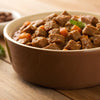How to Transition Your Dog from Wet Food to Dry Food Smoothly
- Houndsy
Table of Contents
- Introduction
- Understanding the Difference Between Wet and Dry Food
- Reasons for Transitioning from Wet Food
- Steps to Transition from Wet Food to Dry Food
- Troubleshooting Common Challenges
- The Role of the Houndsy Kibble Dispenser in Simplifying Feeding
- Conclusion
Introduction
Did you know that approximately 45% of dog owners prefer feeding their pets wet food due to its enticing aroma and texture? While wet food can certainly be a delightful and nourishing option, many pet owners find themselves needing to make the switch to dry food for various reasons. Whether it's for cost-effectiveness, dental health benefits, or dietary recommendations from your veterinarian, understanding how to get my dog off wet food is crucial.
In this blog post, we will guide you through the process of transitioning your dog from wet food to dry food while maintaining their health and happiness. We will address common questions, present helpful tips, and provide step-by-step instructions for a smooth transition. By the end of this post, you will have a comprehensive understanding of how to successfully change your dog's diet and equip yourself with the tools necessary for a hassle-free experience.
As dog parents, we inherently want what is best for our furry companions. Reflect on your current pet feeding routine—does it involve the rich variety of flavors that wet food offers? Or perhaps you’re considering changing this routine? Regardless, the journey of switching your dog's diet can be simple, effective, and satisfying—with the right know-how. Let's dive into the steps required to transition your dog from wet to dry food seamlessly.
Understanding the Difference Between Wet and Dry Food
Before we embark on the transition process, let's clarify the primary distinctions between wet and dry dog food to help you understand why you might want to switch.
Nutritional Composition
Wet dog food often contains a higher moisture content, typically around 75-80%, which can help keep your dog hydrated. However, this moisture can also mean a reduction in vital nutrients when compared to dry kibble. Dry dog food, with its lower moisture content around 10-12%, is nutrient-dense, providing essential vitamins and minerals essential for your dog's overall well-being.
Storage and Shelf-Life
One key advantage of dry dog food is its long shelf life. Unlike wet food, it does not require refrigeration and can be kept for several months without spoilage. This makes dry food convenient for pet parents looking for long-term storage solutions.
Dental Health
Feeding dry food can help improve your dog’s dental health. The crunchy texture of kibble can aid in reducing plaque buildup, promoting healthier teeth and gums. This dental benefit elevates the importance of considering dry food in your dog's diet.
Cost Considerations
Wet food is often more expensive than dry food on a per-serving basis. Transitioning to dry food can help make your pet's diet more budget-friendly while still ensuring they receive adequate nutrition.
Reasons for Transitioning from Wet Food
Understanding your own reasons for wanting to switch to dry food can provide motivation as you guide your dog through this change. Common reasons may include:
- Health Concerns: Some dogs may require a transition to dry food for health-related issues such as obesity or dental problems.
- Cost-Effectiveness: Dry food can be more affordable over time, making it an attractive option for budget-conscious pet owners.
- Dietary Preferences: If your dog has developed a preference for kibble or if you want to rotate their diet, transitioning to dry food could be beneficial.
- Convenience: Dry food is easy to measure, store, and serve, making daily feeding hassle-free.
Steps to Transition from Wet Food to Dry Food
Transitioning your dog from wet to dry food should be done gradually to avoid gastrointestinal upset. Here’s how we can make the switch effectively.
1. Choose High-Quality Dry Food
Selecting a high-quality dry food is fundamental to your dog's health and satisfaction. Look for dry kibble that uses real meat as the first ingredient, contains minimal fillers, and provides balanced nutrition. Ensure that you choose a formula suited for your dog's age, size, and health needs.
2. Create a Transition Plan
You should aim to transition your dog over 7-10 days, increasing the amount of dry food while decreasing the wet food. Here's an example guideline:
- Day 1-2: 75% wet food, 25% dry food
- Day 3-4: 50% wet food, 50% dry food
- Day 5-6: 25% wet food, 75% dry food
- Day 7: 100% dry food
Adjust this timeline based on how well your dog adapts. Some dogs may need a faster or slower transition, especially if they have sensitive stomachs.
3. Monitor Your Dog’s Reaction
As you begin the transition, keep an eye on your dog’s appetite, energy levels, and stool quality. It's normal for some dogs to experience mild digestive adjustments during the switch. If any severe gastrointestinal issues arise, slow the transition and consult your veterinarian.
4. Implement Feeding Changes
Consider adopting more structured feeding habits if your dog is used to free feeding:
- Scheduled Feeding: Offer meals at the same time every day to establish a routine.
- Meal Timing: Limit meal time to about 20 minutes to encourage eating the offered food. After this time, remove any uneaten food, whether wet or dry.
5. Enhance the Dry Food's Appeal
If your pup is particularly finicky, we can bridge the gap between wet and dry by making dry food more appealing. A few tricks include:
- Warm Water: Adding a bit of warm water or low-sodium broth can elevate the aroma and flavor.
- Gradual Mixing: If needed, blend in a small amount of wet food with the dry kibble to entice your dog.
- Top with Treats: Lightly sprinkling some dog-friendly treats or toppers can add appeal.
Troubleshooting Common Challenges
Switching from wet to dry dog food can be met with challenges—let's explore common issues pet owners face during this transition and potential solutions.
1. Refusal to Eat
If your dog is reluctant to eat their new diet, increase motivation by using high-quality treats as incentives. Hand-feeding during the first few days can also spark interest, as some dogs respond positively to personal attention during mealtime.
2. Digestive Upset
Loose stools, diarrhea, or vomiting can arise during the switch. If mild gastrointestinal symptoms occur, you can try temporarily reverting to the old diet, then restart the transition more gradually. If symptoms persist, consult your veterinarian to rule out any underlying health issues.
3. Lack of Interest
Not all dogs respond to the same tricks. If your dog remains uninterested, consider trying different flavors of dry food or switching brands altogether. A change in texture and taste can sometimes make the difference.
The Role of the Houndsy Kibble Dispenser in Simplifying Feeding
As part of our mission at Houndsy, we believe in elevating the daily feeding experience. Our flagship product, the Houndsy Kibble Dispenser, exemplifies this commitment by combining innovative design with practicality.
Key Features
- Perfect Portion Control: With our easy-to-use dispenser, you can effortlessly measure out consistent portions, making each meal simple and satisfying for your dog.
- Ergonomic Crank: Say goodbye to bending down—our dispenser is designed for easy access, ensuring feeding is both convenient and comfortable.
- Stylish Design: Not only does our dispenser work flawlessly, but it also enhances the visual appeal of your pet care routine, complementing modern home decor.
By investing in the Houndsy Kibble Dispenser, we can enhance our feeding rituals while ensuring our furry friends receive the nutrition they need—without compromising on style or functionality.
Conclusion
Transitioning your dog from wet food to dry food can seem daunting at first, but with the right strategy, it can be a smooth and rewarding experience. Remember to take your time, observe your dog's reactions, and make adjustments as needed. With determination and love, we'll ensure our dogs thrive on their new diet while maintaining their health, happiness, and a strong bond with us.
If you're looking to make a seamless transition in your dog’s feeding routine, consider using the Houndsy Kibble Dispenser. This innovative product is designed to elevate your pet's feeding experience while offering remarkable practicality.
FAQs
1. Can I mix wet and dry food during the transition?
Yes, mixing wet and dry food can help transition your dog more smoothly. As you progress, gradually reduce the amount of wet food until your dog is solely on dry food.
2. How long should I expect the transition to take?
Generally, a complete transition should take between 7-10 days. If your dog requires more time, adjust the timeline accordingly based on their individual needs.
3. What should I do if my dog refuses to eat the new dry food?
Try enticing your dog with different flavors, adding warm water or broth, or hand-feeding. If problems persist, consider consulting your veterinarian regarding food quality or potential sensitivities.
4. Will switching to dry food affect my dog’s hydration?
While dry food has lower moisture content, ensure your dog has constant access to fresh water to keep them hydrated.
5. Is it necessary to consult a veterinarian before changing my dog’s diet?
While it's not always necessary, consulting with your veterinarian can provide insights specific to your dog's health and nutritional requirements, especially if they have any pre-existing conditions.













